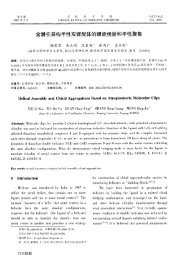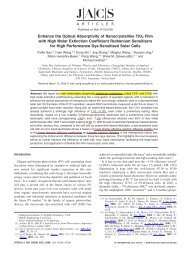Novel hydrodesulfurization nano-catalysts derived from Co3O4 ...
Novel hydrodesulfurization nano-catalysts derived from Co3O4 ...
Novel hydrodesulfurization nano-catalysts derived from Co3O4 ...
Create successful ePaper yourself
Turn your PDF publications into a flip-book with our unique Google optimized e-Paper software.
X. Wang et al. / Catalysis Today 175 (2011) 509–514 511<br />
Fig. 2. Electron microscopic images of the as-made <strong>nano</strong>crystals. (a, b) TEM and HRTEM images of Co 3O 4 <strong>nano</strong>rods, (c, d) TEM and HRTEM images of Co 3O 4 <strong>nano</strong>polyhedra,<br />
(e, f) FESEM images of sulfided <strong>nano</strong>rods and <strong>nano</strong>polyhedra.<br />
image in Fig. 2d shows the clear (1 1 1) and (2 2 0) lattice fringes<br />
with the interplanar spacing of 0.467 and 0.286 nm, respectively,<br />
revealing that the Co 3 O 4 <strong>nano</strong>polyhedra are dominated by a truncated<br />
octahedral shape enclosed by the {1 1 1} and {1 0 0} facets<br />
[22,25]. For the purpose of comparison, the morphologies of two<br />
sulfided <strong>catalysts</strong> after hydrogenation reaction are also observed<br />
by FESEM (Fig. 2e and f). It can be seen that there is no significant<br />
changes between the shape of fresh Co 3 O 4 particles and the<br />
sulfided <strong>catalysts</strong>.<br />
3.3. Catalytic activity<br />
3.3.1. Influence of presulfidation<br />
Prior to the hydrogenation of COS, the cobalt oxides were presulfided<br />
with hydrogen sulfur at different temperatures: 250, 300, 350<br />
and 400 ◦ C. The breakthrough curves for H 2 S over Co 3 O 4 <strong>nano</strong>rods<br />
and <strong>nano</strong>polyhedra are presented in Fig. 3a and b. It can be seen<br />
that the curves for both oxides exhibit similar shape, however, a<br />
significant difference between them is evident. As seen, at the same<br />
sulfidation temperature, for example 250 ◦ C, the penetration time<br />
of H 2 S (defined as the sulfur species in the off-gas can be detected<br />
by GC) for the <strong>nano</strong>rods (Fig. 3a, 42 min) is much longer than that<br />
for the <strong>nano</strong>polyhedra (Fig. 3b, 18 min). This phenomenon indicates<br />
that the Co 3 O 4 <strong>nano</strong>rods have a higher reactivity and capacity<br />
towards H 2 S than the <strong>nano</strong>polyhedra [6,7], which may probably<br />
lead to a better catalytic performance for the HDS of COS. When<br />
the sulfidation temperature is increased, the similar variation is displayed<br />
over two cobalt oxides. It is found that the penetration time<br />
of H 2 S is shortened when the temperature exceeds 300 ◦ C, such as<br />
<strong>from</strong> 120 min at 300 ◦ C decreasing to about 70 min at 350 ◦ C for the<br />
<strong>nano</strong>rods (while for the <strong>nano</strong>polyhedra, <strong>from</strong> 60 min at 300 ◦ C to<br />
45 min at 350 ◦ C), suggesting that high temperature is not suitable<br />
for sulfidation process. This is due to that the sulfidation of metal<br />
oxide is an exothermal reactions, which could give occasion to the<br />
local increasing of sulfidation temperature and eventually results in<br />
metal oxide partly reduced to metal or the agglomeration of metal<br />
<strong>nano</strong>particles by hydrogenation (above 316 ◦ C) [13,26], therefore<br />
detrimental to the sulfidation.<br />
The HDS catalytic activities of the above sulfided <strong>catalysts</strong> are<br />
determined at 200 ◦ C, and the results are shown in Fig. 4. It is clear<br />
0.40<br />
0.35<br />
0.30<br />
0.25<br />
250 ºC<br />
300 ºC<br />
350 ºC<br />
400 ºC<br />
0.40<br />
0.35<br />
0.30<br />
0.25<br />
250 ºC<br />
300 ºC<br />
350 ºC<br />
400 ºC<br />
C/C0<br />
0.20<br />
0.15<br />
C/C0<br />
0.20<br />
0.15<br />
0.10<br />
0.05<br />
NRs<br />
0.10<br />
0.05<br />
NPs<br />
0.00<br />
0<br />
15<br />
30 45 60 75 90 105 120 135 150 165 180<br />
Time /min<br />
0.00<br />
0<br />
15<br />
30<br />
45<br />
60<br />
75 90 105 120 135 150 165 180<br />
Time /min<br />
Fig. 3. Breakthrough curves for H 2S at different temperature over Co 3O 4 <strong>nano</strong>rods and <strong>nano</strong>polyhedra.
















